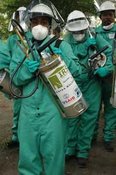Malaria and DDT
This article was researched and written by a student at Texas Tech University participating in the Encyclopedia of Earth's (EoE) Student Science Communication Project. The project encourages students in undergraduate and graduate programs to write about timely scientific issues under close faculty guidance. All articles have been reviewed by internal EoE editors, and by independent experts on each topic.
Contents
Introduction Life cycle of Malaria. (Source: CDC (Malaria and DDT) )
The African American Environmentalist Association and numerous other organizations believe that DDT (dichloro-diphenyl-trichloroethane) insecticide should be used to prevent deaths from malaria in African countries. DDT is an organochlorine pesticide that has been used as an insecticide in agriculture and to combat insect vectors of diseases such as malaria and typhus. Because of its effectiveness at killing insects with few acute effects on humans, DDT had been a mainstay to fight malaria, a parasitic disease that is a growing health threat in Africa and other parts of the world. Also, these organizations believe that DDT should be used in India, Brazil and Mexico, where 69% of all reported cases of malaria occur. According the World Health Organization (WHO), malaria afflicts hundreds of millions of people and causes millions of human deaths each year.
Controversy
The use of DDT for controlling malaria is highly controversial. Many argue that, historically, DDT has been very effective at reducing mosquitoes. Others argue that DDT use introduces a toxic agent into the food chain, harming wildlife in particular, and causes considerable of bioaccumulation. Also, the overuse of DDT leads to DDT-resistant mosquitoes. Therefore, DDT is tightly controlled in most countries, although it is widely agreed that its strategic use can play a part in the fight against malaria. In general, the WHO agrees that strategic indoor spraying of DDT, in the form of indoor residual spraying, is an acceptable way to control malaria in many parts of the world. The Stockholm Convention is responsible for establishing a current international consensus regarding the use of DDT. This consensus states that DDT use should eventually be eradicated, but that effects on the prevalence of malaria due to its withdrawal should be closely monitored. This agreement does allow, however, for certain exemptions regarding DDT use. These exemptions were won after a highly active lobbying campaign by DDT advocates leading up to the final decision in 2000.
Benefits of DDT use
Female Anopheles mosquitoes enter dwellings and bite humans, transmitting malaria in many cases. Such devices as air conditioners and mosquito nets are highly effective at preventing malaria. However, many countries with severe, endemic malaria are poor and tend to have dwellings that are very primitive and open-air. While there are many tools for combating malaria, there is nothing that has been as long-acting, cost-effective, and powerful as DDT. DDT can be sprayed lightly on interior walls, around windows, or on ceilings to combat mosquitoes effectively for one year or more.
South Africa is currently the most active government in promoting the use of DDT for mosquito vector control. The mining industry of southern Africa is the most active private sector entity in promoting the use of DDT spraying. DDT spraying is a highly cost-effective way of reducing the instances of malaria among the workforce. DDT as seen as a tool for reducing employee absenteeism and, thus, improving economic health.
Implementation
 Spraying DDT in Zanzibar. (Source:USAID)
Spraying DDT in Zanzibar. (Source:USAID) DDT’s effectiveness when sprayed on the walls and roofs of dwellings can be described as a sequential series of conditional probabilities:
- First, DDT can work effectively to repel the mosquito from entering the dwelling. DDT residues applied to interior walls act as a powerful repellent of mosquitoes.
- Second, DDT can irritate the mosquito. Given that some mosquitoes will still enter the sprayed house, DDT can act as an irritant that will cause many mosquitoes to exit the dwelling before biting.
- Finally, DDT is effective at killing mosquitoes. The toxic action of DDT will reduce the survival rate of mosquitoes that enter and remain in a dwelling.
Indoor residual spraying (IRS) is one of the primary vector control interventions for reducing and interrupting malaria transmission. In recent years, however, it has received relatively little attention. Recent data confirms the efficacy and effectiveness of IRS in malaria control in countries where it was implemented well. According to the WHO, effective implementation of IRS with DDT or other recommended insecticides should be a central part of national malaria control strategies where this intervention is appropriate.
Control is implemented with the objective of reducing malaria morbidity and mortality and accelerating progress towards global and national malaria targets. There are important considerations, however, that must be taken into account when considering whether to introduce or scale up IRS. In particular, there must be sufficient capacity to deliver the intervention effectively, to prevent unauthorized use of public health pesticides, and to manage insecticide resistance. Intensified research efforts are needed, for example to develop new insecticides, long-acting formulations and improved application technologies.
Along with producing IRS manuals and guidelines, the World Health Organization will support countries to collect and analyze data, towards determining potential effectiveness and feasibility of IRS in the national context, and with planning and implementing the intervention.
Adverse effects
DDT accumulation in the environment can lead to a wide array of health problems for humans and wildlife in general. DDT is considered an environmental pollutant and a general toxin. Misuse of DDT can also lead to insect resistance, which can build up in insects at incredibly fast rates.
Further Reading
- African American Environmentalist Association. DDT.
- Malaria Foundation International. DDT for Malaria Control.
- Malaria Foundation International. DDT page.
- Stockholm Convention of Persistent Organic Pollutants. Information System on DDT in Disease Vector Control.
- World Health Organization. 2006. Indoor residual spraying: Use of indoor residual spraying for scaling up global malaria control and elimination (PDF). WHO Position Statement.
- Encyclopedia of Earth articles: